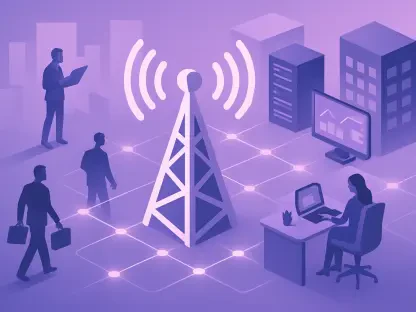In a groundbreaking moment for artificial intelligence, OpenAI has launched ChatGPT 5 in August of this year, marking a significant leap forward in the realm of conversational technology. This latest iteration isn’t merely an incremental update but a transformative tool that blends advanced reasoning with unparalleled accessibility, aiming to reshape how society engages with AI. From students seeking personalized learning to businesses streamlining complex operations, ChatGPT 5 promises to deliver solutions that feel both intuitive and revolutionary. Its release has sparked widespread excitement, positioning it as a critical step toward artificial general intelligence (AGI), a long-standing goal in the tech world. As this powerful model becomes available to users across the globe, the implications for productivity, education, and beyond are profound. This article explores the standout features that define ChatGPT 5, traces its evolutionary path, and examines the far-reaching effects it is expected to have across various sectors. Additionally, attention will be given to the ethical considerations and developmental challenges that accompany such a pioneering advancement. Prepare to uncover how this cutting-edge AI is set to influence daily life and industry landscapes in remarkable ways, offering a glimpse into a future where technology and human interaction are more seamlessly intertwined than ever before.
Cutting-Edge Innovations in ChatGPT 5
The core of ChatGPT 5 lies in its remarkable technological advancements, setting a new standard for what conversational AI can achieve. OpenAI has integrated traditional language processing with sophisticated reasoning capabilities, resulting in a model that can tackle intricate queries with a depth previously unseen. Described by the company’s CEO, Sam Altman, as offering “instant PhD-level expertise” on nearly any subject, this AI delivers responses that are not only accurate but also contextually rich. A standout feature is the drastically reduced latency, enabling conversations that flow smoothly and mirror human interaction more closely than any predecessor. This speed ensures users aren’t left waiting, whether they’re brainstorming ideas or seeking quick solutions to pressing problems. Beyond mere dialogue, the model excels in problem-solving, handling everything from complex mathematical equations to nuanced ethical discussions with a clarity that surpasses earlier versions like GPT-4. These enhancements make ChatGPT 5 a versatile tool, capable of serving diverse needs with precision and efficiency, and they signal a bold move toward creating AI that can think and respond with near-human proficiency across a wide array of topics.
Another layer of innovation in ChatGPT 5 is its expanded multimodal functionality, building on the foundation laid by GPT-4o. This model can process not just text but also images, audio, and potentially video inputs, opening up new avenues for interaction that go beyond typed conversations. Imagine an AI that can analyze a visual diagram and explain its components in detail or interpret audio cues to provide tailored feedback—these capabilities make the user experience richer and more dynamic. Additionally, efforts to minimize “hallucinations,” or fabricated responses, have led to a significant boost in factual accuracy, addressing a common critique of past models. The broader and more up-to-date knowledge base further ensures that answers remain relevant, overcoming limitations seen in earlier iterations where outdated information could hinder usefulness. Together, these features position ChatGPT 5 as a comprehensive system that not only communicates effectively but also adapts to varied formats of input, pushing the boundaries of what AI can accomplish in real-time engagement and establishing it as a pivotal development in the journey toward AGI.
Democratizing Access to Advanced AI
A cornerstone of OpenAI’s mission with ChatGPT 5 is ensuring that this powerful technology reaches a wide audience, reflecting a commitment to inclusivity in the AI space. The model is accessible to all users through the ChatGPT platform, regardless of whether they are on a free plan or subscribed to premium tiers like Plus, Pro, or Team. Free users can tap into the core functionalities with standard usage limits, making it possible for anyone with an internet connection to experience cutting-edge AI without financial barriers. Meanwhile, paid subscribers benefit from expanded access, including higher usage thresholds and priority processing, which cater to the needs of professionals and organizations requiring consistent, high-volume interactions. This tiered structure strikes a balance between broad availability and specialized support, ensuring that both casual explorers and dedicated users find value in the platform. By eliminating the need for additional software downloads or complex setups, OpenAI has made engagement with ChatGPT 5 as straightforward as logging in, a decision that lowers entry hurdles and invites widespread adoption across diverse demographics.
The implications of this accessibility are far-reaching, particularly for those who might otherwise be excluded from advanced technological tools. Students in under-resourced regions, small business owners with limited budgets, and independent developers can now leverage a model that offers expert-level assistance at no upfront cost. This democratization fosters innovation by empowering individuals and smaller entities to experiment with AI in ways that were previously reserved for well-funded enterprises. For instance, a freelance coder can use ChatGPT 5 to debug intricate scripts, while an educator might employ it to craft customized lesson plans tailored to specific student needs. OpenAI’s strategy here aligns with a broader vision of advancing human potential through technology, ensuring that the benefits of ChatGPT 5 extend beyond corporate boardrooms to classrooms, home offices, and creative spaces. This approach not only amplifies the model’s impact but also sets a precedent for how future AI developments might prioritize inclusivity, potentially reshaping societal access to transformative tools in the years ahead.
Tracing the Path of ChatGPT’s Evolution
Understanding the significance of ChatGPT 5 requires a look at the remarkable journey of its predecessors, each building toward the sophistication seen today. The story began with GPT-3, launched several years ago, which introduced the world to a massive language model boasting 175 billion parameters and an unprecedented ability to generate human-like text. Though groundbreaking, it often struggled with conversational nuance, prompting the development of ChatGPT based on GPT-3.5, which refined dialogue flow and introduced safety measures to curb inappropriate outputs. Subsequent models, such as GPT-4, brought multimodal processing into play, allowing the AI to interpret images alongside text and demonstrate enhanced reasoning skills strong enough to pass professional exams. Later iterations like GPT-4 Turbo and GPT-4o focused on speed and cost-efficiency, improving responsiveness and setting the stage for the comprehensive upgrades now seen in ChatGPT 5. This progressive timeline reflects a deliberate strategy of addressing past shortcomings while expanding capabilities, culminating in a tool that stands as a testament to years of iterative refinement in AI research.
The evolution of these models also highlights how user feedback and societal needs have shaped OpenAI’s direction over time. Each release responded to specific challenges, whether it was the robotic tone of early text generation or the factual inaccuracies that occasionally marred responses in prior versions. With ChatGPT 5, launched this year, the integration of advanced reasoning with traditional language skills marks a culmination of lessons learned, delivering a model that not only communicates effectively but also thinks critically across diverse contexts. This historical context underscores the importance of continuous improvement in technology development, showing how each step forward builds a foundation for the next. As ChatGPT 5 combines the strengths of its forerunners with fresh innovations, it serves as a benchmark for what AI can achieve when guided by a commitment to progress and adaptability, offering insights into the meticulous process behind creating tools that resonate with real-world demands.
Revolutionizing Industries and Everyday Life
ChatGPT 5 is not just a technological marvel; its potential to transform various sectors is already generating significant anticipation. In the realm of personal productivity, this model offers precise assistance for tasks like drafting documents, coding intricate software, or solving multifaceted problems, effectively streamlining workflows for users at all levels. Imagine a professional writer receiving real-time suggestions that enhance clarity and style, or a programmer debugging complex algorithms with pinpoint accuracy—these scenarios illustrate how daily efficiency can be elevated. Beyond individual use, the education sector stands to benefit immensely, as ChatGPT 5 can act as a personalized tutor, adapting explanations to match diverse learning styles and breaking down complicated concepts for students. Researchers, too, gain a powerful ally, with the AI’s ability to analyze vast datasets and summarize intricate literature, potentially accelerating discoveries in critical fields such as medical science or environmental studies. This capacity to tailor support across academic and personal spheres underscores the model’s versatility in fostering growth and innovation.
Turning to the business landscape, ChatGPT 5 is poised to redefine operational dynamics with its enhanced reasoning and automation potential. Companies could deploy it to power customer support systems that handle multi-step inquiries with human-like understanding, reducing response times and improving client satisfaction. Financial analysts might leverage its data-processing prowess to generate detailed market insights, while integrations with widely used software ecosystems could automate repetitive tasks like meeting summaries or project tracking. For the average user, the natural conversational tone and multimodal features—capable of processing varied inputs—create interactions that feel effortless, whether brainstorming creative ideas or troubleshooting technical issues. The cumulative effect across these domains suggests a profound shift in how technology integrates into workflows and lifestyles, positioning ChatGPT 5 as a catalyst for efficiency and engagement in both professional and personal contexts. Its influence is likely to ripple through industries, setting new standards for what AI can contribute to societal advancement.
Navigating Ethical and Safety Responsibilities
As ChatGPT 5 expands the horizons of AI capability, OpenAI remains steadfast in addressing the ethical and safety dimensions that accompany such progress. A primary focus lies in mitigating biases that could skew outputs, ensuring that responses reflect fairness and accuracy rather than perpetuating harmful stereotypes or misinformation. While specific strategies behind these efforts remain under wraps, the emphasis on responsible AI development signals a proactive approach to safeguarding user trust. This commitment is particularly crucial as the model’s influence grows, touching on sensitive areas like education and decision-making in business. The potential for AI to shape opinions or guide actions necessitates rigorous oversight to prevent unintended consequences, a challenge that OpenAI appears dedicated to tackling. By prioritizing these considerations, the organization aims to align technological breakthroughs with societal well-being, reinforcing the idea that innovation must be paired with accountability to achieve sustainable impact.
Equally important is the ongoing effort to curb the spread of inaccurate information through ChatGPT 5, a concern that has haunted earlier AI models. Enhancing factual reliability involves complex processes, likely including refined training data and algorithmic adjustments, to minimize instances where the AI might generate misleading content. This focus on accuracy is vital for maintaining credibility, especially when users rely on the model for critical tasks such as academic research or professional analysis. The broader industry trend of balancing rapid advancement with ethical standards is mirrored in OpenAI’s approach, reflecting a growing recognition that AI’s role in society comes with significant responsibility. As ChatGPT 5 becomes a staple in various applications, these safety measures will play a pivotal role in shaping public perception and ensuring that its deployment enhances rather than disrupts the informational landscape. This dual focus on ethics and reliability underscores a mature perspective on AI’s integration into everyday life.
Insights into Development and Future Hurdles
The journey to ChatGPT 5’s launch this August followed months of anticipation, with early hints of progress shared by Sam Altman as far back as February. Initial speculation pointed to a possible release late last year or early this year, but OpenAI’s accelerated timeline ultimately delivered a model that surpassed expectations in both scope and capability. Behind the scenes, the development process likely involved overcoming significant technical obstacles, from optimizing computational resources to refining the integration of reasoning and language models. This achievement reflects a determined push to meet growing user demands for smarter, faster AI, demonstrating how strategic planning and innovation can align to produce a tool that feels both timely and forward-thinking. The successful rollout serves as a testament to the team’s ability to navigate complex challenges, setting a high bar for what can be accomplished in the field of conversational technology within a compressed timeframe.
Looking ahead, however, some industry experts caution that future advancements beyond ChatGPT 5 may face substantial barriers, particularly in terms of computational limits. Scaling AI to even greater heights could require breakthroughs in hardware or entirely new architectural approaches, challenges that might slow the pace of progress in the coming years. Despite these potential roadblocks, the current state of ChatGPT 5 showcases a resilience in overcoming earlier developmental hurdles, suggesting that OpenAI is well-equipped to address emerging issues. The balance between pushing technological boundaries and managing practical constraints will likely define the next chapter of AI evolution, with lessons from this release informing strategies for tackling future complexities. As the field continues to evolve, maintaining this momentum while anticipating and resolving such challenges will be critical to sustaining the transformative potential of tools like ChatGPT 5 in the broader landscape of artificial intelligence.
Reflecting on a Milestone Achievement
Looking back, the introduction of ChatGPT 5 in August of this year stood as a defining moment in the trajectory of artificial intelligence, encapsulating years of relentless innovation by OpenAI. Its blend of rapid response times, deep reasoning skills, and multimodal versatility marked a significant departure from past models, offering users a tool that felt remarkably close to human interaction. The commitment to accessibility ensured that this powerful technology reached a global audience, while its impacts reverberated across education, business, and personal productivity, reshaping how tasks were approached. Ethical safeguards and safety measures underscored a responsible rollout, addressing critical concerns about bias and accuracy. As attention now shifts to the future, stakeholders are encouraged to explore how ChatGPT 5 can be integrated into specific workflows, tailoring its capabilities to unique challenges. Continued dialogue around potential technical limitations will also be essential, ensuring that subsequent developments build on this foundation with even greater foresight. This milestone not only highlighted what AI achieved but also paved the way for considering how such tools might further evolve to meet society’s ever-changing needs.









